Words and Photographs by Phil Johnston
Whatever your professionwildlife biologist, cattle rancher, small-scale organic farmer, or just an outdoor enthusiastunderstanding how to correctly interpret carnivore feeding signs can enhance your time in the great outdoors, safeguard your means of subsistence, and guarantee accuracy in data gathering for wildlife research and management. Carnivores are portrayed as bloodthirsty killing machines in centuries of folklore and decades of Hollywood films, but the average person in the twenty-first century tends to believe the most dramatic and terrifying explanations when they come across a carcass in the woods. I’ve witnessed people swear that a mountain lion killed a deer they discovered, even though the carcass had no signs of food and there was a highway a short distance away. Understanding the behavior, feeding mechanisms, and preferences of various species can help you sort through complex tales of predation, scavenging, and kleptoparasitism. Interpreting the feeding signs of predators and scavengers can become extremely complex very quickly, especially when multiple species have shared a carcass. The term “kleptoparasitism” describes the situation in which one animal takes food that has been acquired, collected, or killed by another. This ecological interaction is crucial in determining how various predators and scavengers will feed. We would like to take this opportunity to alert you to the fact that this article contains extremely graphic images of dead animals in various states of decay and mutilation. If you would prefer not to see such images, please stop reading.
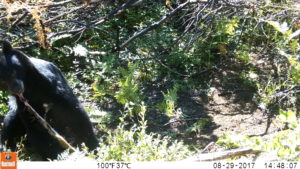
Lets start with the basics. Bigger animals inflict more serious harm on carcasses, while smaller animals inflict less serious harm and leave more parts behind. This obvious fact is demonstrated by prey items of all sizes, from sparrows to elk. When a sharp-shinned hawk consumes a variety of thrush, it is necessary to remove the numerous body feathers because the small, fluffy feathers would be difficult for the hawk to eat. As a result, when you examine the kill site, almost all of the body feathers have been carefully removed and are piled on the ground. A mountain lion will eat a varied thrush whole, leaving behind only a few flight feathers and any body feathers that happened to fall off as the bird was being gobbled up. The small amount of meat on the bird is definitely not worth the time it would take to remove every single feather, and each individual feather does not represent nearly the same level of gastronomic hardship for the lion as it would for the sharp-shin.
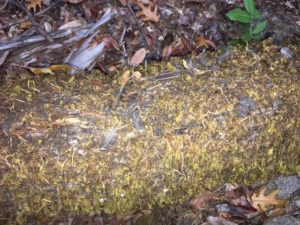
Many of the largest bones in the body, such as the vertebrae, femurs, pelvises, skulls, and scapulae, will be crushed and either fully or partially consumed when a mountain lion feeds on a deer carcass. Most of the bones and skeleton will stay in place after a group of smaller scavengers, including foxes, fishers, skunks, bobcats, eagles, and vultures, feast on a deer carcass and remove all of the meat. Using just this basic information, look at the images below of a deer carcass taken by Paul Glasser in northwest Oregon and try to identify what has been feeding on it.
| Photos by Paul C. Glasser |
Observe how the back ribs have been broken through, with some of them being forced to strange angles. Although the hind legs have been amputated, the tibia, fibula, and femurs are still articulated with the skeleton. The rumen’s fleshy exterior has been almost completely consumed, exposing its insides, but the deer’s heart and lungs remain uneaten. The deer’s front right leg is completely absent, but this is not surprising considering that the scapula’s articulation with the ribs and vertebrae is wholly muscular rather than skeletal. Last but not least, the animal’s position is consistent with a natural dying pose and the corpse has been left in the middle of the creek, suggesting that it has not been drugged or moved. The aforementioned are all excellent markers of mesocarnivore feeding, including bobcats, foxes, fishers, raccoons, skunks, and others. , and serve as warning signs for larger predators like coyotes, wolves, black bears, and mountain lions. After this buck was struck by a car on a nearby road and left to die in this creek bed, Paul set up a trail camera at the location and captured the following images: a coyote and a bobcat were seen eating the carcass. Let’s analyze this tale in terms of the deer’s various organs and body parts as well as the feeding sign they display.
Digestive Organs: As obligate carnivores, bobcats and mountain lions typically leave the digestive tracts of their herbivorous prey untouched. On occasion, however, they may even remove these organs and conceal them with debris a short distance from the remainder of the carcass. The fact that the abomas have been opened and consumed in the aforementioned instance implies that another omnivorous scavenger was active before Paul’s camera caught the bobcat. The majority of omnivorous mesocarnivores, including bears and coyotes, will consume at least some of the rumen or intestines; occasionally, they will consume the entire tract and its partially digested contents. Black bears have been seen to eat deer scat directly, and according to Benjamin Kilham’s excellent book “Among the Bears,” this helps the bears’ own guts become infected with the bacteria that deer need to digest plant matter, which increases the bears’ capacity to extract nutrients from vegetation. It’s possible that eating ruminant stomach and intestines directly benefits bears and other omnivorous mesocarnivores in a similar way. To put it briefly, more omnivorous species tend to exhibit indifference and occasionally the opposite inclination, whereas bobcats, mountain lions, and other obligate carnivores take great care to avoid sabotaging the digestive tract and its contents.
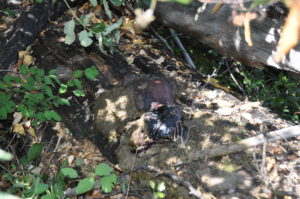
Internal Organs (heart, liver, lung, kidney):
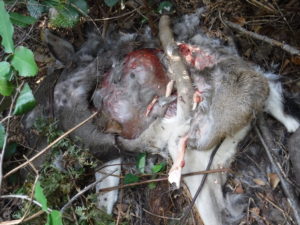
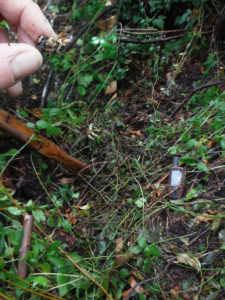
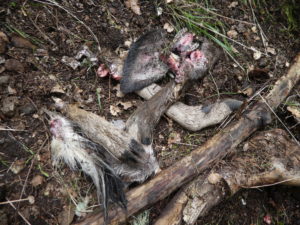
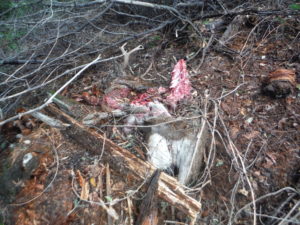
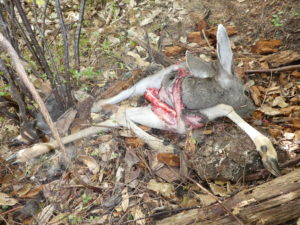
Placement, caching, and tidiness: Different carnivore species have varying preferences for the locations and methods of feeding on carcasses. They also vary in their capacities for moving and caching carcasses. While a black bear might be able to completely bury an elk carcass in bushes and forest duff, a gray fox would undoubtedly be unable to accomplish this and would have to remove individual pieces of meat to be cached separately nearby. Furthermore, a mountain lionor any other smaller animal, for that matterwould be unable to move such a large carcass and would be forced to eat it where it died, unlike a grizzly bear, which may decide to drag an elk carcass a few hundred yards to a more private place to feed. Additionally, animals differ in their morphology, which influences their willingness and ability to move through different terrain while dragging a carcass. In certain situations, you can identify a predator simply by looking at the path the carcass was dragged.
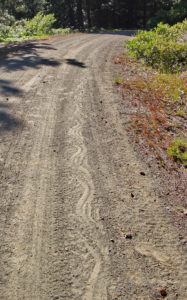
The term “hiding” describes how the carcass is positioned overall in the landscape, and mountain lions are very particular about this. They will almost always drag the carcass to a protected area to feed if it is small enough for them to moveanything smaller than a deer. When available, mountain lions prefer to graze beneath cover such as a willow thicket, a stand of dense young firs, or a rock overhang. This behavior accomplishes three things at minimum: 1) it lessens the carcass’s visibility; 2) it provides shade, which lessens the meat’s deterioration and, consequently, its olfactory detectability; and 3) it shields the mountain lion from the elements while it feeds. The terrain, the proximity of the nearest suitable cover, and the size of the kill all influence how far a mountain lion will drag its kill. In the mountains of the Pacific Northwest, adult deer kills typically occur between 40 and 150 yards away, though I have witnessed cases where lions have transported their prey much farther. Because they frequently drag their kills downhill, lions frequently leave their victims in the bottom of drainage ditches or next to creeks.
| Left: Drag mark where a female lion drug a buck downhill to a secluded feeding site in the brush in the background of the frame. Right: The buck from the left picture after the kill had been kleptoparasitized by a black bear, and drug out of the lions secluded feeding site and left out in the open. Note the drag mark leading backwards from the buck and up to the top right corner of the frame. |
Black bears frequently drag kills from the location where they find them as well, but the location of these drags frequently lacks the tactical significance of mountain lion drags. I find it incomprehensible that bears will frequently drag a carcass a hundred yards or more only to leave it fully exposed in the sun. While mountain lions typically avoid these barriers, bears prefer to cross or break through barriers like fences or thickets in order to drag large carcasses in a straight line. Whereas mountain lions typically drag large carcasses right up to a fence and feed on them from the other side, through the fence, rather than attempt to drag the carcass over the fence, large black bears are much more powerful and are capable of dragging larger carcasses over fences or bending and breaking strong wire fences. Additionally, bears eat in a semi-haphazard manner, tearing at the most accessible part of the deer, which can leave behind carcasses that are mutilated in ways that appear asymmetrical and random. This, in my opinion, illustrates the difference between bears and mountain lions. While deer carcasses are a bear’s bread and butter, mountain lions feed on them in a manner that is efficient and discrete because they occur so infrequently that it’s possible they don’t have the opportunity to develop a systematic feeding order. It is typical for the kill of a bear to end up partially scattered, with a few pieces of hide, bone, and fur remaining in the various beds the bears used to feed over the course of several days. In these situations, the spinal column is frequently found to be mostly intact, occasionally with the pelvis still articulated, along with one or more scapulae and a nearby skull. When wolves and coyotes eat ungulate carcasses, it usually results in a yard sale because each member of the pack scatters the carcass around before going to their own favorite corner to eat. Mountain lions are remarkably clean with their kills when compared to all other predators in North America; however, this does not include bobcats and lynx, which have similar eating habits but are not prone to breaking large bones as previously mentioned.
| Left: A lion kill stolen by a black bear who drug the kill out from the lions cache to leave it in the full sun on a summer day. Note the atypical feeding pattern which resulted in the deer being torn in half. Right: a buck killed by a lion but mostly fed on by a bear. Note how the meat has been pulled and shredded off the ribs but the ribs have not been eaten themselves lions always feed by eating the rib bones and meat simultaneously. |
When animals in any manner conceal their food, it’s referred to as caching. The phrase can be used to describe both grizzly bears burying a moose carcass and Clark’s Nutcrackers hiding pinyon pine seeds. By covering deer and other kills with forest duff and debris, mountain lions store their kills. There is no actual burying or digging involved, and although the mountain lions’ caching behavior is primarily confined to the layer of forest debris above the dirt, some dirt may wind up in the mound atop the carcass. Mountain lions can cover a carcass with moss, twigs, grass, and dead leaves. They do this by slowly rotating their front paws and stroking them repeatedly and carefully until the carcass is covered from all sides. Although they don’t always cache their kills, mountain lions seem to exhibit this behavior more frequently in regions where kleptoparasitism is a major problem for them. A mountain lion will typically fold a kill into a tidy little bundle before caching it to reduce the amount of meat exposed to dirt. One of the main distinctions between black bear caches and those made by mountain lions is that black bears also pile debris on top of carcasses to reduce the likelihood that other carnivores will discover them. When bears store a carcass, it frequently gets a lot of dirt and debris inside it (in the thoracic and abdominal cavities), covering any exposed meat in dirt. Because bears cache in a relatively careless manner, I have discovered numerous deer carcasses where the deer was packed with dirt like a Thanksgiving turkey. It appears that mountain lions take great care to prevent dirt and other undesirable spoiling elements from contaminating the meat, as evidenced by how neatly their kills are kept. The overall quantity of material used is another helpful indicator for differentiating between bear and lion caches, in addition to the amount of dirt on the meat and inside the carcass. Mountain lions typically use the minimal amount of material necessary to complete the task, while black bears frequently go overboard and unnecessarily create enormous mounds of debris
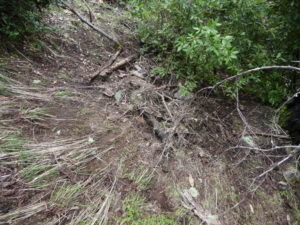
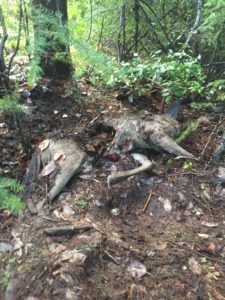
A black bear’s tracks, scats, stomp marks on trails, rub marks on trees, and distinctive bear beds will also be present around any carcass that it is feeding on. Although it is outside the purview of this article, it is very helpful to be generally familiar with all of these indicators when interpreting kill-sites. Bear beds, however, are noteworthy because they frequently lie directly atop the cache mound, giving the cache a unique appearance. By repeatedly rubbing, rolling, and pawing the earth, black bears hollow out extremely deep beds. They also leave a definite circular imprint directly next to or on top of the cached carcass.
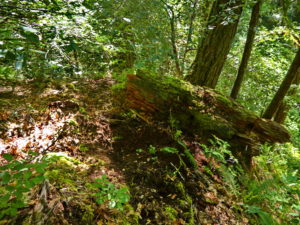
Please take note that black bears can be extremely protective of carcasses. Some of them may even attack you if you try to move them away from the kill. When people approach a kill site, mountain lions, on the other hand, are rarely defensive of the kills. Nevertheless, it is vital to be extremely aware of your surroundings, especially if there are bear signs nearby.
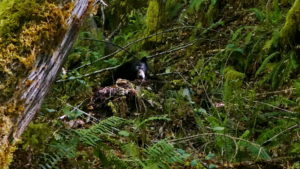
Animals use latrines, or recurrent defecation sites, for various purposes. Mountain lions dig latrines at kill sites where they frequently overeat, and raccoons dig latrines at the base of trees where they sleep. The idea that wild cats in North America cover their scats is mainly untrue; this is more typical of domestic cats. However, mountain lions do cover their scats when they kill prey. I think the only purpose of this behavior is to reduce the smell of the kill site. I have witnessed instances where a mountain lion has chosen to repeatedly defecate in a stream while it was feeding on its kill close by, instead of setting up a conventional latrine. Mountain lion latrines are simply heaps of duff that are roughly 18 to 24 inches in diameter and 8 to 16 inches high, containing anywhere from one to five scats. The water works just as well to keep the scent down as forest duff and doesn’t require any of the labor! A lion may decide to build a fresh little latrine pile each time it urinates at a kill site, or it may decide to keep building on an existing latrine. In any case, this behavior is specific to mountain lions and is diagnostic. Similar to how some domestic dogs are drawn to domestic cat scat (much to their owners’ dismay), black bears will open up the latrine after taking over a lion’s kill and eat the lion scats inside. Black bears scat wherever they spend time, including next to their beds, and they don’t try to hide their scats.
The mountain lion often experiences kleptoparasitism, and in certain areas, grizzlies, black bears, condors, and other dominant scavengers take the lion’s share of their kills. The density of black bears in Humboldt County, California, where I work, is among the highest in the world. Because of this, practically all of the deer that mountain lions kill between April and Decemberwhen bears are most activeare stolen. This makes interpreting ungulate kill-sites more difficult for researchers, farmers, wildlife managers, and outdoor enthusiasts. It can be very challenging, if not impossible, to confirm that a mountain lion killed an animal after a black bear had been feeding on it for several days, but there are a few key indicators to look for, including latrines, old caches, hair that has been pulled out, and killing wounds.
The mountain lion killed the animal by using its strong jaws and canine teeth in killing wounds. Usually, to achieve this on ungulates, the throat is bit and the larynx is crushed, causing the animal to asphyxia. Mountain lions can simply crush the back of the skull with a powerful bite on smaller deer, such as yearlings and fawns, but older animals and those with antlers often have too tough and bony a skull to allow for this. In their struggle to subdue ungulates, mountain lions have also been known to bite ungulates’ noses, leaving noticeable bite and claw marks. Using a knife to cut open the skin of the throat and look for puncture wounds and clotted bloodwhich is the result of wounds that bleed internally while the animal is still aliveis one very efficient method of determining whether or not a mountain lion killed the animal. Sometimes puncture wounds are visible enough to show the predator’s two upper and two lower canine marks; in these cases, measuring the wounds with calipers or a ruler can be useful. On a mountain lion, the distance between the tips of its upper canines is typically between one and 6? and 1. 75?, and about 1. 5? between the lower canines. Black bears are usually 1. Although some smaller bears may overlap with larger lions, black bears usually attack animals from the back of the head and neck, with an 8 to 2 inch gap between the upper and lower canines. Furthermore, nearly every kill you find with a bear on it was probably stolen because black bears are extremely unlikely to catch a healthy adult deer (though they decimate fawns in the early summer). The animal was most likely killed by a bobcat or lion if there is clotted blood and dog wounds in its throat (bobcats can kill deer too, but they are unable to break through big bones).
| Left: I accidentally discovered this kill when I heard the bear caching the carcass and went to investigate. Knowing that bears are mostly unable to capture adult deer I suspected it had been killed by a lion so I skinned out the neck to confirm. Sure enough, puncture wounds and clotted blood (pictured right) pooled on the underside of the neck tell that this animal was killed by asphyxiation the typical kill method of mountain lions. |
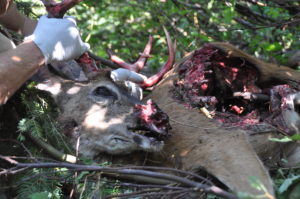
If a bear has been feeding on a kill for a long time and has destroyed most other evidence, such as neck wounds, then plucked hair may be the only way to identify the original predator. As previously noted, a mountain lion will painstakingly pluck an ungulate’s hair before consuming any part of its body, one mouthful at a time, leaving behind a substantial mound of characteristically clumped fur. If there are bear signs all over the kill site and only small fragments of bone are left, go for a walk and search the nearby shady and protected nooks for piles of fur that have been plucked. This will confirm that the kill was originally made by a bobcat or a mountain lion. Once more, if the kill is fresher, the state of the big bones and the extent of the cache can be used to differentiate between bobcat and lion kills. Are all the large bones intact or only partially cached? Fully cached with large bones crunched? Mountain lion. While ancient latrines and caches may not always withstand the antics of a feeding bear, they frequently do and can offer unmistakable proof of mountain lion feeding. Follow any drag marks that extend past the carcass as far as you can to possibly discover the location where the lion first removed and stored the digestive organs or where it removed hair from the flank. If that doesn’t work, search for latrines that the bear may or may not have opened and eaten.
Interesting FactsDid you know
Fun math: Mountain lions can purr and scream, but they cannot roar.
If a lion appears, make a big impression and stick with the group. If attacked, fight back and be loud. Do not try to run away Reaction to humans.
Mountain lions try to avoid humans
Mesocarnivores & Small Prey
The feeding sign of mountain lions can differ significantly from that of large ungulate kills when they consume mesocarnivores and other small prey, such as rabbits or small domestic animals, but many of the previously mentioned guidelines still apply. Even with small kills, mountain lions still remove some hair; however, the less hair they remove, the smaller the piece of prey. Because they may be consumed in their whole, very small animals like chipmunks, mice, warblers, voles, and woodrats can be difficult or impossible to interpret signs of and confirm evidence of predation. However, the sign left by feeding mountain lions has a characteristic appearance for medium-sized animals like foxes, raccoons, fishers, and house cats, where the tail, digestive organs, and pieces of the skull are still present. Mountain lions are usually found almost entirely intact, and it is unusual for a lion to consume any more than the proximal 1/3 of the tail, which has more meat, as they are generally not keen on eating tails, which promise a mouthful of hair and bone and not much meat. Furthermore, the bonier portions of the skull, such as the palate with its rows of molars and the supraoccipital plate, are disregarded, just like it is with larger prey like deer. However, mountain lions frequently consume the distal ends of the nasal, premaxillae, and turbinate bones when they eat deer kills; however, mesocarnivores do not eat these parts. In fact, it is typical to find the entire snout and nose still in place on mesocarnivores killed by mountain lions, with the skull crushed and consumed from the orbits backwards. However, bobcats usually lack the ability or desire to genuinely crush the brain case of even small mesocarnivore prey, like mink, and instead leave intact skulls with canine puncture marks in the brain case as a result of their kills. Mesocarnivore skulls in their whole are extremely uncommon at mountain lion kill sites, and this can be a useful distinguishing feature between their kills and those of smaller carnivores. The digestive organs of mesocarnivore prey are left whole and in a tidy pile by mountain lions and bobcats, but other carnivores like coyotes, wolves, and domestic dogs may or may not consume these organs.
| Left: Two American mink skulls, both of whom were killed and fed on by a bobcat. Right: a northern raccoon skull which was killed and fed on by a mountain lion. Notice that the mink skulls are both completely intact, and that the left skull bears canine puncture marks while the right skull is completely unbroken, while the much larger raccoon skull was largely destroyed by the feeding mountain lion. |
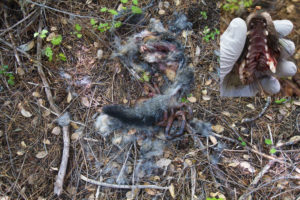
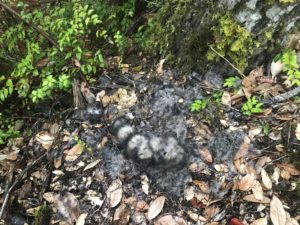
Larger animals like coyotes, beavers, large raccoons, and bobcats are frequently cached by mountain lions, but smaller prey like gray foxes, fishers, and rabbits are usually too small to warrant caching by a mountain lion (indicating that the lion was able to consume the animal completely in one sitting). The female mountain lion who consumed the raccoon in the above photo spent 14 hours here, most of which was probably spent napping rather than eating. The raccoon was not cached. The main characteristics of mountain lion kills on mesocarnivores are 1) almost entirely consumed skeleton, 2) crumpled skull, and 3) intact digestive organs. Interpreting smaller prey kill-sites can be more difficult because the predator spent less time consuming the animal, which results in less accumulated sign for you to read.
FAQ
Do mountain lions eat raccoons?
Do mountain lions eat dogs?
Do mountain lions eat squirrel?
Does a mountain lion have a predator?